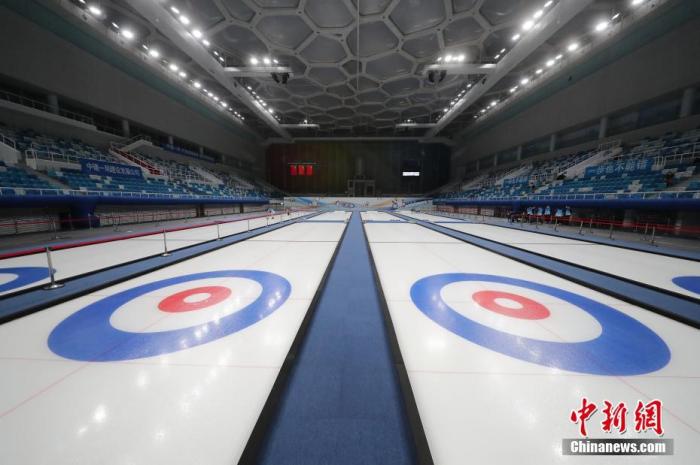(Beijing Winter Olympics) "Ice Cube" Reconstruction Project Manager: Deciphering "Water-Ice Conversion" and Awaiting the Winter Olympics
China News Agency, Beijing, January 22, title: "Ice Cube" Reconstruction Project Manager: Deciphering "Water-Ice Conversion" and Awaiting the Winter Olympics
Author Men Rui
Transforming the swimming pool into a curling rink, the National Aquatics Center is the first sports venue in the world to achieve "water ice conversion".
In a recent interview with a reporter from China News Agency, Liu Jun, the project manager of the Construction Development Company of China Construction First Bureau and the project manager of the "Ice Cube" curling venue renovation project, deciphered the reasons behind the "water-ice conversion", "one hall, three temperatures" and "green Olympics". Tech code.
The picture shows citizens experiencing the Ice Cube main stadium after the renovation.
Image source: Visual China
"Water-ice transition" faces the challenge
The "water-ice conversion" link is complex, and the construction requirements are meticulous.
According to Liu Jun, the renovation requires setting up a steel structure frame in the emptied swimming pool, laying concrete prefabricated panels, waterproof and thermal insulation layers on top, and then laying ice drain pipes.
With air conditioning and dehumidification system, the high temperature and high humidity water sports environment is adjusted to the low temperature and low humidity ice sports environment.
Because there is no precedent to follow, the transformation process faces many difficulties.
Liu Jun said that in addition to technical difficulties, construction management also faces challenges.
"In order to reduce the inconvenience caused by the renovation process, the team introduced building information modeling technology, and after continuous testing and training, the construction speed was improved, and the 'construction non-stop' was basically realized."
At present, the construction time of the "water-ice conversion" ice rink structure has been reduced from 45 days to 20 days, and the ice-making process can be delivered in 30 days.
During the renovation, public tours and sports activities can still be carried out as usual.
In December 2019, the National Aquatics Center completed the first "water ice conversion".
After the test match, it is necessary to dismantle the curling track, restore the swimming pool, and record the experimental data.
Due to the outbreak of the new crown pneumonia, foreign experts were originally scheduled to be unable to be present for guidance.
Talking about this experience, Liu Jun expressed his deep impression.
"After the first renovation, the team learned repeatedly based on the video records and mastered the installation technology. Although the epidemic was sudden, the team was not caught off guard and independently completed the demolition and installation of the curling rink twice."
"One Pavilion, Three Temperatures" Technology Helps
The ice surface is -8.5°C, 1.5 meters above the ice is 8~12°C, and the auditorium is 16~18°C. Inside the "Ice Cube", the division of three temperature zones in the same space is realized.
Liu Jun introduced that this temperature setting is to meet the needs of curling events while taking into account the physical comfort of athletes and spectators.
"The temperature of the ice surface is adjusted by the refrigerant in the ice making machine and the ice making pipe. The temperature and humidity at 1.5 meters above the ice surface are adjusted by the peripheral refrigerator, dehumidifier and air conditioning unit, and then the air is supplied to the venue through the bag air duct. The temperature of the auditorium is controlled by the air outlet under the seat." Liu Jun said.
Since the stadium and the auditorium are in the same space, how to use invisible "barriers" to separate different temperature zones has become a challenge.
"In layman's terms, an 'air arc' is formed between the upper part of the ice rink and the auditorium through the 'positive and negative pressure' technology, and the ice rink is 'covered', thereby separating the competition environment and the viewing environment." Liu Jun introduced , This method has undergone careful experiments, and can monitor and precisely control the temperature and humidity in the venue at any time through the intelligent building management system.
Excellent answer to "Green Olympics"
Liu Jun introduced that the re-use of Olympic venues has always been a technical challenge. Dismantling the venues is a waste, and retaining the venues requires high operation and maintenance costs.
The "water ice conversion" technology helps the National Aquatics Center realize the sustainable operation model of "summer swimming and winter curling".
In order to meet the needs of athletes to prepare for the competition, "Ice Cube" not only built a new permanent athlete's locker room, but also added a temporary athlete's locker room transformed from abandoned containers.
"This design effectively saves costs. After the event, the container can be moved to other places and transformed into a coffee shop and other places, which is environmentally friendly and energy-saving." Liu Jun said that after the event, the space where the temporary locker room is located will be vacated. Parking spaces to solve the parking problem of people visiting the museum.
In order to ensure the technical support for the operation of the "Ice Cube" venue during the Beijing Winter Olympics, Liu Jun and team members have entered closed-loop management.
"After three complete 'water-ice transition' tests, we are technically very confident." He said that the team, whose average age is only 28 years old, is full of fighting spirit and is preparing for the opening of the game.
(Finish)

